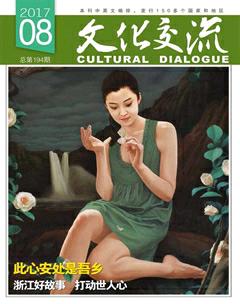永不过时的“孝”文化
骆恒光
中國国学博大精深,是个探索不尽的宝库。近几年,随着又一波研读国学的热潮到来,市面上涌现出很多相关的书籍,其中有一本很特别——徐继宏主编的《二十四孝书法篆刻集》。从书名即可看出,其内容核心是“孝”,形式是书法和篆刻。

徐先生是我很熟悉的同道朋友,他为何选用书法篆刻来表现“孝”的主题,说来也是机缘巧合。徐先生18岁入伍,在部队工作之余也常习文舞墨,颇有成果,并因此两次荣立三等功。他转业到地方后,从事新闻出版工作,对中国传统文化愈加有浓厚的兴趣,结识了不少文学艺术界的师友,故在书法篆刻上钻研更深,多有造诣。在美丽的石头上将金石书画的艺术韵味与传统孝文化范本融为一体,既具丰富内涵,又有隽永魅力,这是徐先生萌发策划《二十四孝书法篆刻集》一书的初衷。
中国传统文化从“孝道”“礼仪”开始,德孝是做人的最起码要求,也是处世的最基本规范,凝结着中华文明的核心要义。《二十四孝》作为前人倡导孝行的范本,在中华民族的发展史上发挥过积极的作用。就文化传承而言,取其精华,弃其糟粕,是任何一个时代都需要正视和面对的问题,有些故事比如弃官寻母、扇枕温衾、涤亲溺器、百里负米、戏彩娱亲等,今天读来依然让人感动,也有借鉴意义;当然,有些事例比如恣蚊饱血、尝粪忧心、埋儿奉母等则不合时宜了。
随着我国人口老龄化趋势的加剧,倡导孝文化,践行孝为先,有着重要的时代意义。越来越多的空巢老人非常需要情感上的慰藉,老人的赡养、养老、临终关怀等问题,都需要一份孝心来呵护。
曾有人说现在的社会世风日下、人心不古,纵然是由很多因素造成的,但优良传统的缺失是一个重要的因素。《二十四孝》作为中国孝文化的专著,传承至今已有600多年历史。孝文化具有血浓于水的强大凝聚力,其本身蕴含着对祖先的崇拜、对亲人的眷顾、对乡土的依恋等丰富内涵,它是中国传统社会的立国之本与社会之基,历来为国人所重视和倡导。孝行作为中国传统文化的首要价值观和首德,仍然是当代中国人最为看重的核心价值之一,也是建设民族共同精神家园的精神基础。
说起编辑意图,徐先生说,他编辑此书正是因为看到俗话所言“百善孝为先”这一点,才付诸实施。
此书由西泠印社出版社出版后,徐先生送来一册,粗略翻看,很是亲切。书中汇集的不少作品出自西泠名家之手,而这些同道我大都相识相交,比如在当代印坛颇有影响、篆刻艺术造诣颇深的余正、鲍复兴、吴静初、吴莹、李早等。在徐先生的相邀下,这些方家及后起之秀不吝指教,并以书刻鼎助,使此书有了熏陶人的艺术素养的作用。徐先生实在是颇具独到的出版眼光的。
二十四位西泠印社中人,二十四方印章,二十四幅书法,还有印社执行社长、九二高龄的刘江先生题写的书名。篆刻艺术之美、金石石质之美融为一体,赏心悦目,陶冶情操。
徐继宏先生编著的《二十四孝书法篆刻集》是一本及时的、有助于正能量传播的图书,在将传统美德发扬光大的同时,也给现代人带来了精神食粮。孝是一个永恒的主题,此书也有着永不过时的启迪作用和时代意义。
(本文图片由徐继宏提供)
Traditional sinology, or “National Studies” as often referred to in modern China, is a treasure trove. Recent years saw a new wave of passion in the studies of China-related subjects worldwide. One of the many published books related to this extensive and profound subject that caught my eyes is in Calligraphy and Seal-cutting, published by the Xiling Seal-engraving Society Press and compiled by Xu Jihong, a friend I have known for years.
Xu Jihong joined the army at the age of 18. In his army life, he spent most of his free time writing and practicing calligraphy as a hobby. After transferring to civilian work, he has been working in the press and publishing industry, building his connections in the literature and art circles and further honing his skills in calligraphy and seal-cutting.
The idea behind the book, that took many years to take shape, is to combine the significance of the unique filial culture of China with the beauty of Chinese seal-engraving art, and more importantly, to remind todays people that the filial piety will never go out of style.
is a classic text of Confucian filial piety written by Guo Jujing during the Yuan dynasty (1260-1368). The text was extremely influential in the mediaeval Far East and was used to teach Confucian moral values.endprint
The concept of filial piety has played a strong role in Chinese culture and ethics since ancient times and encapsulates the sum and substance of traditional Chinese doctrines regarding how one should conduct in society. Although some of the stories depicted in the book, such as the tradition of filial mourning, in which a person had to temporarily put aside whatever he/she was doing when his/her parent(s) died and mourn for three years, and the extreme example of Guo Ju deciding to kill his son so that he could free up his sons share of the familys food consumption to feed his mother, are regarded as negative examples in contemporary times. And the sayings such as “When a ruler wants a subject to die, the subject must die; when a father wants a son to die, the son must die”, and “A loyal subject should be sought from a family with filial sons” have become outdated by modern standards.
For todays people, the teachings of the stories are still highly educational, especially in an aging society that has become a global issue. Chinas fast growing number of ‘empty nesters are creating a series of social problems, the solution of which boils down to more a spiritual issue than material support. In this sense, this is where the word ‘filial piety comes in.
It is important for todays younger generations to understand the message of many stories in the classic text by Guo Jujing. In “He Fanned the Pillow and Warmed the Blanket”, the author described how Huang Xiang fanned his fathers pillow to ensure that his father could sleep comfortably at night during summer and wrapped himself with his fathers blanket to warm it in winter. And it is not hard to be touched by the story “He Carried Rice for His Parent”, about a young Zhong You travelling a distance away from home and carrying back a sack of rice to feed his parents. He ate only wild vegetables. Many years later, when he became a wealthy official in the Chu state, his parents had already died. He often recalled his past and lamented, “I can never eat wild vegetables and carry rice back for my parents anymore.”
It is no exaggeration to say that the ancient text by Guo Jujing and the book by Xu provide timely food for thought for todays readers to reevaluate the moral value of ‘filial piety.
Liu Jiang, the 92-year-old chair of Xiling Seal-engraving Society, contributed the calligraphic title for the book. Many of the 24 calligraphic and 24 seal-cutting works included in Xus book are from masters representing the Xiling Seal-engraving Society.endprint

